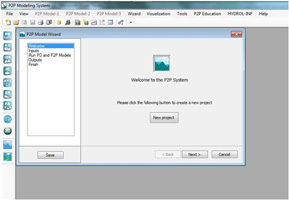|
|
|
|
| Civil, Construction and Environmental Engineering |
|
|
|
|
Research Home NSF-P2P | EPSCoR | IPTM | HYDROL-INF
Introduction
This Windows-based software is a comprehensive hydrologic modeling package. It consists of four major components: (1) microtopography-controlled puddle-to-puddle (P2P) overland flow modeling system (P2P-Model), (2) interactive P2P educational system (P2P-Education), (3) 2D/3D visualization and hydrotopographic analysis tools (P2P-Tool), and (4) HYDROL-INF modeling system.
P2P-Model is the key component of this P2P software. It consists of five models that have various levels of model complexity and applicability, including P2P Model-1, P2P Model-2, P2P Model-3, Multiscale Model-1, and Multiscale Model-2. Based on surface puddle delineation, the P2P models simulate the dynamic P2P filling, spilling, merging, and splitting overland flow processes for either impervious or infiltrating surfaces. The Windows interface allows users to prepare their input data, run the models (both puddle delineation and P2P modeling), and visualize simulation results in formats of tables, graphs (2D and 3D), and animations. The wizard facilitates computer-guided, step-by-step P2P overland flow modeling.
P2P-Education is an interactive teaching-learning system. The software, with enhanced visualization capabilities, integrates the new modeling techniques, computer-guided learning processes, and education-oriented tools in a user-friendly Windows-based interface (A web-based version of P2P-Education also is available). P2P-Education is specially designed for three major user levels: elementary level (Level 1: K-12 and outreach education), medium level (Level 2: undergraduate education), and advanced level (Level 3: graduate education). Depending on the levels, users are guided to different educational systems. Each system consists of a series of mini “libraries” featured with movies, pictures, and documentation related to fundamental theories, varying scale experiments, and computer modeling of overland flow generation, surface runoff, and infiltration processes.
P2P-Tool consists of a series of stand-alone tools for visualization and hydrotopographic analysis, including (1) 2D and 3D visualization and animation tools, (2) puddle delineation tool (PD), (3) scanned data combination tool (S-C), (4) image-based depression storage computation tool (IDS), (5) image correction tool (IC), (6) coordinate transformation tool (XYT), (7) slope removal tool (SR), (8) fractal analysis tool (FA), (9) object-based image segmentation tool (OBIS), and (10) surface topographic parameters tool (STP). The PD tool also is an essential part of P2P modeling used for characterizing surface microtopography, delineating puddles and their relationships, determining flow directions and accumulations, and precisely computing maximum depression storage (MDS) and maximum ponding area (MPA).
HYDROL-INF is an independent hydrologic modeling system. A modified Green-Ampt infiltration-runoff model is the central part of the HYDROL-INF system. The model is capable of determining the ponding condition, simulating infiltration into a layered soil profile of arbitrary initial water distributions under unsteady rainfall, and partitioning the rainfall input into infiltration and surface runoff. Two distinct periods, pre-ponding and post-ponding, are taken into account. The model tracks the movement of the wetting front along the soil profile, checks the ponding status, and, in particular, handles the shift between ponding and non-ponding conditions. The model also is able to continuously simulate the rainfall-infiltration-runoff processes and soil water drainage and redistribution for complex rainfall patterns that include both wet time periods with unsteady rainfall and dry time periods without rainfall. A revised version of HYDROL-INF that accounts for the hydraulic influences of surface ponded water has been incorporated into the P2P models to simulate infiltration and unsaturated flow.




Documents (new version updated on June 17, 2013)
|
P2P Modeling System Introduction Users Manual |
P2P Tools S-C Tool Manual SR Tool Manual XYT Tool Manual IC Tool Manual IDS Tool Manual PD Tool Manual FA Tool Manual OBIS Tool Manual STP Tool Manual |
HYDROL-INF Introduction Users Manual |
